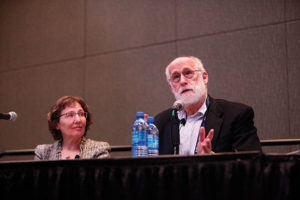If medicine is a science and based on facts and research, why do physicians disagree? Why is there controversy on recommended treatment plans for common diseases? If the experts can’t agree, how can patients make the “right” decision?
 The difficulty—and often uncertainty—surrounding medical decision-making was the topic of Sunday morning’s ATS Lecture Keynote Series.
The difficulty—and often uncertainty—surrounding medical decision-making was the topic of Sunday morning’s ATS Lecture Keynote Series.
“Controversy in medicine is not new. What is new is the media coverage surrounding medical controversies,” said Pamela I. Hartzband, MD, assistant professor at Harvard Medical School and attending physician in the Division of Endocrinology at Beth Israel Deaconess Medical Center, who shared the podium with Jerome E. Groopman, MD, professor of medicine at Harvard Medical School and chief of experimental medicine at Beth Israel Deaconess Medical Center in Boston.
The doctors wondered why medical experts come to different conclusions about studies recommending or denouncing statins to reduce high cholesterol, how much Vitamin D an individual should take, the effect of salt on high blood pressure, and if adults should take low-dose aspirin to stave off heart attacks or strokes. And what are patients to believe?
Traditionally, three different methods have been used in classic medical decision analysis.
- Linear scale.Using a rating from 0-1 for decision-making. Zero is death and 1 is perfect health. You assign a number that represents the impact a side effect would have on your quality of life.
- Time trade-off.How many years of life would you be willing to give up, or trade-off, to avoid the side effect?
- Standard gamble.Imagine that there is a magic pill that can completely prevent a certain outcome, but in a certain percentage of cases, it causes instant death. Estimate what odds you’d be willing to take to completely avoid a certain outcome versus the chance that it might kill you right off the bat.
“Recent research in cognitive science has shown that these three methods are all severely flawed,” said Dr. Groopman. “The problem is that you cannot reliably forecast your life in the future. You cannot understand the impact that a certain outcome will have if you’ve never experienced it. Also, medical conditions are not static, they are dynamic. Illnesses change in an individual over time and also people adapt to their conditions.”
Using the philosophy of Sir William Osler, Drs. Groopman and Hartzband opted to “listen to the patient, because if you know how to listen, he’s telling you the answer.” They interviewed scores of patients and investigated how they made their medical decisions. Ultimately, they found common threads that allowed them to categorize different mindsets that lead patients to their medical decision-making. The mindsets are:
Minimalist or maximalist.A minimalist believes less medicine is often the best approach while a maximalist believes doing everything medically possible to achieve the best health is the best approach.
Naturalism orientation or technology orientation.Naturalism defines someone who looks for natural solutions if they are available. Someone technology-oriented wants the latest and most advanced treatment available.
Believer or doubter.A believer is ready to confidently take medicine just as soon as the doctor prescribes it. A doubter will do more research, wondering if the treatment is worse than the disease.
They determined that patients, as well as doctors, have these mindsets.
“Doctors and experts have these mindsets, and it can impact the advice they give,” said Dr. Hartzband.
Ultimately, in making medical decisions, Drs. Groopman and Hartzband concluded you have to take into consideration your mindset and the patient’s mindset, as well as stories they hear related to their conditions. All of these support and direct their decision-making.
